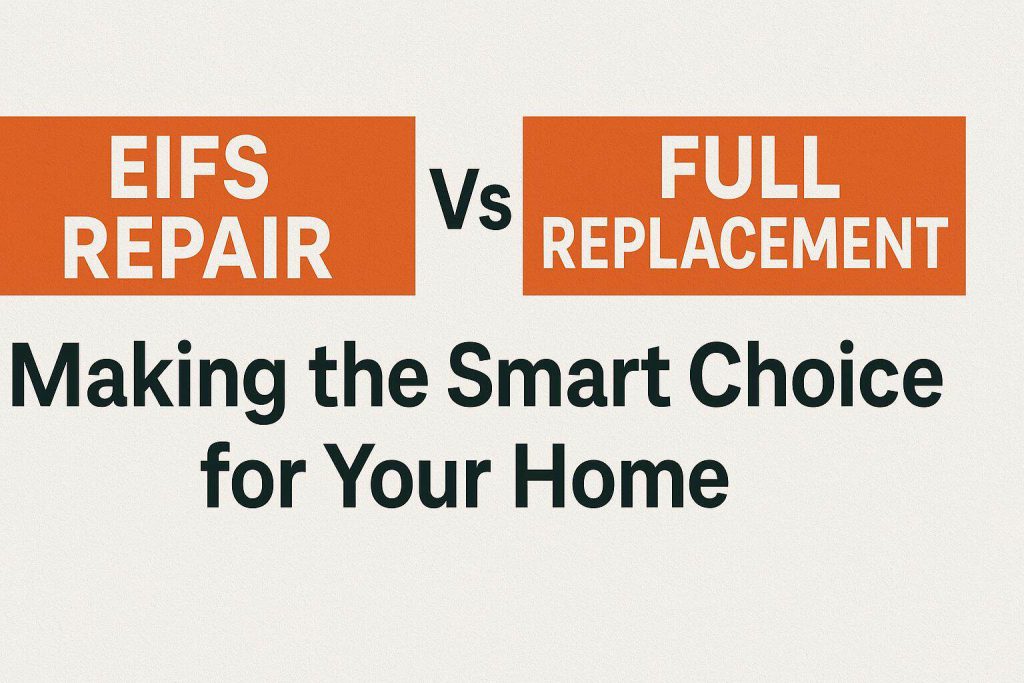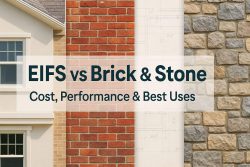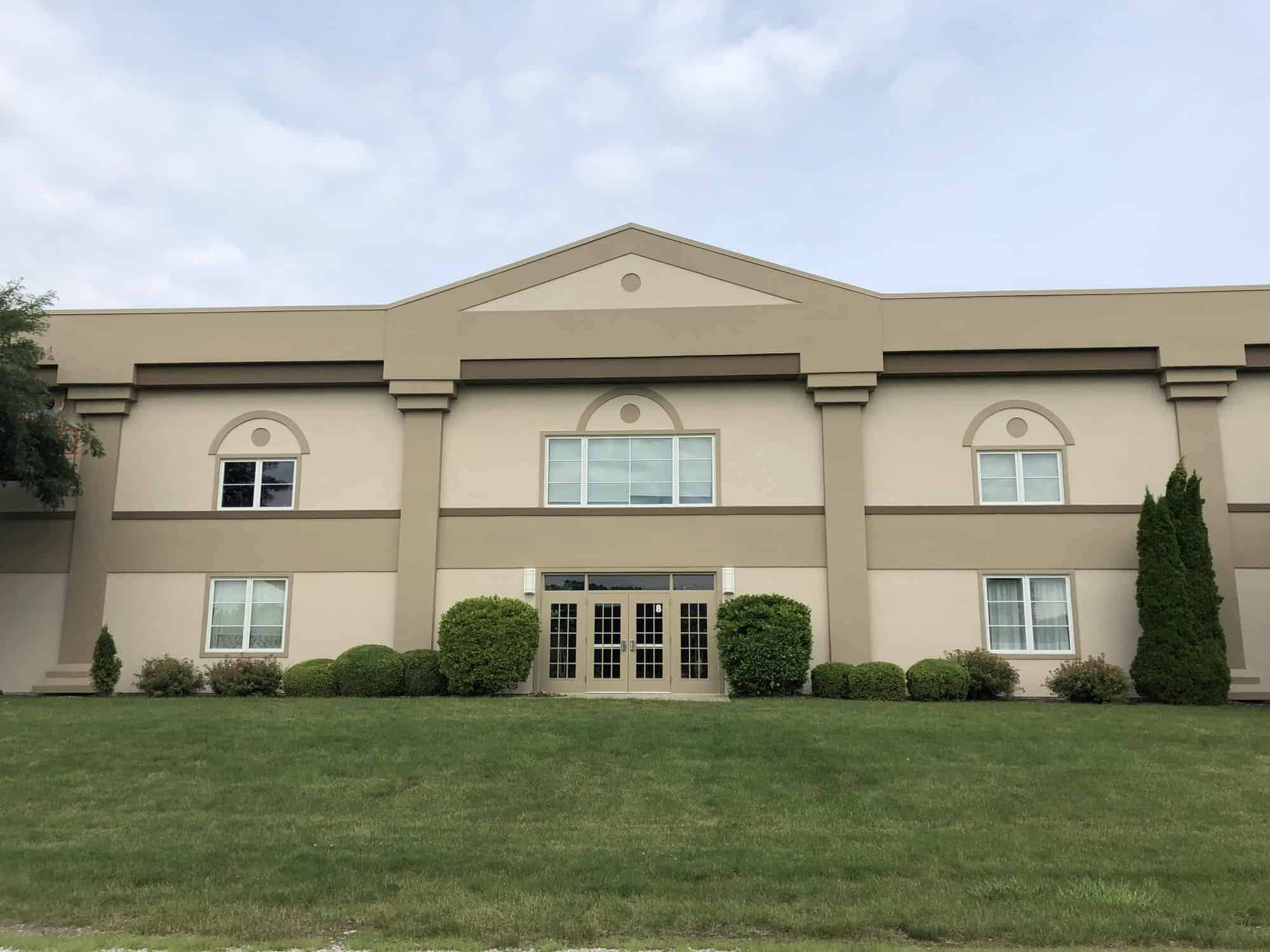Navigating the Options: A Guide to Understanding When to Repair or Replace Your EIFS System

Fed up of ugly damaged siding on your house? Don’t know how to fix it? Choosing between EIFS repair and a full replacement can be difficult. With the right facts and understanding the pros of each option, you can make the smartest choice for your home.
Understanding EIFS: What Is Exterior Insulation Finishing System?
EIFS, also known as Exterior Insulation Finishing Systems, is insulation for your home. It has multiple layers: insulation board, base coat, reinforcing mesh, and finish coat. It is popular in construction due to its seamless look and energy efficiency. To understand EIFS, one must know the components and their job.
The insulation board prevents heat transfer between the interior and exterior. The base coat protects against moisture and provides strength. The mesh adds durability and stress resistance. The finish coat adds aesthetic appeal and shields from elements.
EIFS is versatile in design. It can be customized to mimic different styles or textures. Homeowners can have their desired look while benefiting from advanced insulation tech. Before replacing EIFS systems, consult with pros who specialize in repair. It can be more cost-effective and efficient.
Pro Tip: EIFS repair: saving you money and headaches, so you can spend more time enjoying life’s other expensive problems.
The Benefits of EIFS Repair: Cost-Effective and Efficient
Opting for EIFS repair over replacement can save you money! Plus, it boosts insulation efficiency, reducing energy use and utility bills. Repair is a time-efficient solution and won’t disrupt your daily routine. Enjoy the perks of a cost-effective, efficient exterior with EIFS repair!
Pro Tip: Regular maintenance and timely repairs can extend the lifespan of your EIFS system and maximize performance.
Say “EIFS later!” to your old exterior – don’t wait for “just a crack” to act!
When to Choose Full EIFS Replacement: Signs and Indicators
EIFS Replacement: Knowing When to Opt for Full Replacement
If damage is spotted on your home’s exterior, full EIFS replacement may be needed. Here are 3 signs that point to this:
- Severe, Unrepairable Damage: When EIFS has bad structure or moisture issues that can’t be fixed, full replacement is required.
- Mold or Mildew: Visible mold or mildew growth means there are underlying issues that can only be solved with a full EIFS replacement.
- Outdated System: An old EIFS system that doesn’t meet codes needs to be replaced in order to have a modern, compliant exterior.
For tailored advice, it’s best to speak to professionals familiar with EIFS replacement techniques.
Fact Source: DryHome Roofing & Siding – EIFS Repair Vs. Full Replacement: Making the Smart Choice for Your Home. EIFS Repair or Replacement? Make the right choice or else you could end up with a DIY disaster!
Comparing EIFS Repair and Replacement: A Comprehensive Guide
EIFS Repair or Replacement: A Comprehensive Comparison
Weighing up between EIFS repair and replacement for your home? Consider these key differences.
Comparing EIFS Repair and Replacement:
| Repair | Replacement | |
|---|---|---|
| Cost | Cheaper | More costly |
| Time | Quicker | Slower |
| Complexity | Simple | Complex |
| Energy Efficiency | No change | Increased eff. |
Cost, time, complexity, and energy efficiency are all factors you should take into account. Generally, repair is cheaper and takes less time. But with replacement comes the chance to improve energy efficiency.
Plus, factors specific to your situation should be considered. A professional should assess the condition of your existing EIFS system and any underlying issues.
Pro Tip: Get advice from an expert in EIFS systems to pick the right option for your home renovation.
Remember, in home maintenance, you’re only a crack away from a punchline!
The Longevity of EIFS: Repair or Replace for Lasting Results?
EIFS Repair or Full Replacement: Choose Wisely for Long-Term Results.
When debating the longevity of EIFS, deciding between repair and replacement is key for lasting results. Carefully weigh your options to protect your home investment and keep it looking great.
Repairing EIFS gives you a chance to fix specific issues like cracks, water infiltration or damaged insulation. Fixing these problems on time can extend the lifespan of the EIFS system and protect its functionality. But, if there is widespread structural damage or severe deterioration of the cladding, you may need to replace it.
Unique factors like climate, maintenance practices and initial installation quality affect the decision-making process. Knowing these variables helps you decide if a repair will fix the problem or a full replacement is necessary for long-term results and to avoid future problems.
For example, one homeowner had minor wall cracks and opted for repair. With the right repairs and maintenance, they were able to protect their investment and extend the life of their EIFS for many years. This shows the importance of making an informed choice based on individual circumstances for the best outcome.
To sum up, take into account the longevity of EIFS when considering repair or full replacement. With understanding of the details that impact lifespan and professional help, you can make the right choice for lasting results and protecting your home investment. Don’t forget, you can always attempt a DIY EIFS repair and end up with a patchwork masterpiece!
DIY EIFS Repair: Steps, Tools, and Precautions
- Assess the Damage: Inspect areas for cracks, water infiltration, or other signs of damage. This will help figure out what repair work is needed.
- Gather the Required Tools: Ensure you have the right tools like a putty knife, caulk gun, wire brush, EIFS meshes, trowel, primer, adhesive, paint scraper, sanding block, gloves, and goggles.
- Prepare and Repair: Clean the area with a wire brush and remove debris with a paint scraper. Apply primer and fill any cracks or holes with EIFS adhesive. Put the EIFS mesh over the repaired area for reinforcement.
- Finishing Touches: Allow time to dry before applying a coat of paint that matches your existing finish. Double-check for smoothness and texture consistency with adjacent wall surfaces.
- Remember to follow safety guidelines throughout the repair process to avoid accidents or injuries.
- If you’re not sure about DIY EIFS repair, hire professionals.
Take action now! Don’t let bad repairs ruin your home’s appearance.
Hiring Professionals for EIFS Replacement: What to Look For
When seeking a contractor for EIFS replacement, there are three key factors to consider: expertise, credentials, and references.
Look for contractors experienced in EIFS replacement like Indiana Wall Systems, and make sure they are licensed and insured. Ask for references to check their reputations and read reviews/testimonials for insights into their professionalism. Taking these steps ensures a successful EIFS replacement, avoiding disappointment and costly rework.
Mother Nature has seen it all, so be sure to invest time in finding a professional with the right expertise and experience to deliver high-quality workmanship.
Environmental Considerations: Repairing vs Replacing EIFS
Environmental Impact: Repairing or Replacing EIFS?
When deciding between repairing or replacing EIFS, there are some environmental factors to consider. Here’s 3 points to remember:
- Sustainable Choice: Repairing is a greener option. It needs fewer materials, reducing waste and the carbon footprint of the project.
- Recycle EIFS: If you’re replacing, explore recycling options. Using recycled materials decreases the demand for new resources and avoids landfill waste.
- Green Building: Both repairing and replacing EIFS offer chances to incorporate green building practices. For example, energy-efficient insulation or eco-friendly replacements can make your home more sustainable and energy-efficient.
The EPA states that buildings account for 40% of energy consumption in the US. So, understanding warranties is key. EIFS repair and replacement coverage can protect you from unexpected repairs.
Understanding Warranties: EIFS Repair and Replacement Coverage
EIFS warranties: Coverage for repairs and replacements.
When it comes to safeguarding your home, understanding EIFS warranties is essential. These warranties provide repair coverage and replacement guarantees, giving you assurance that your investment is safe.
Repair coverage under EIFS warranties makes sure that all the needed repairs to your EIFS system are taken care of. This covers any damages or issues with the system over time. Replacement guarantees, on the other hand, cover you in case a full replacement of the EIFS system is needed.
It is important to note that EIFS warranties deliver various levels of protection based on the manufacturer and the warranty terms. Some warranties may provide extended periods of coverage while others may have some limitations or exclusions. Thus, it is essential to look at the warranty details carefully to comprehend what is covered and for how long.
Understanding EIFS warranties is not only regarding protecting your home, but also making informed decisions when it comes to repair or replacement needs. By knowing what your warranty covers, you can figure out if repairing certain issues is a feasible choice or if a full replacement would be more suitable.
The Cost Breakdown: Analyzing EIFS Repair Vs. Replacement Expenses
Analyzing Costs: Comparing EIFS Repair to Replacement
Breaking down expenses for EIFS repair versus full replacement is key when making a financial decision. With the table below, homeowners can compare costs and decide which works with their budget.
Table:
| Category | EIFS Repair Expenses ($) | Full Replacement Expenses ($) |
|---|---|---|
| Materials | $2,000 | $5,000 |
| Labor | $1,500 | $3,500 |
| Equipment Rental | $200 | N/A |
| Permits | $100 | $200 |
| Total | $3,800 | $8,700 |
EIFS repair is usually cheaper upfront. But, replacement has higher expenses due to needing new materials and extra labor.
Long-term savings should be considered too. By replacing, homeowners can avoid future repair costs that may come from existing EIFS problems.
To save money and get the best results:
- Get quotes from different contractors to compare prices and services.
- Assess the damage or deterioration of the EIFS system.
- Think about any underlying structural issues that might affect the long-term performance of either option.
- Consider your home’s condition and its resale value when you make your budget for EIFS repairs or replacement.
By factoring in all these factors, homeowners can manage EIFS repair expenses without sacrificing quality or damaging their home finance. Attempting to understand regulations and building codes for EIFS work is like attempting to solve a Rubik’s Cube with no sight – just when you think you have it, you realize a piece is missing and everything falls apart.
Local Regulations and Building Codes: Compliance for EIFS Work
When working with EIFS, local regulations and building codes must be followed. These rules govern the standards and specs for EIFS in the area. Adherence is key for safety and quality.
Renovation permits may be required to confirm compliance. They help verify the project meets safety standards and any needed inspections can be done. Get permits before starting repair/replacement work.
In Central Indiana, EIFS reqs may vary by location. Homeowners/contractors should consult local authorities and understand building codes before undertaking EIFS repairs/replacements.
Hire a pro contractor experienced in EIFS to comply with local regulations/building codes. They understand reqs and can guide homeowners through the process. Also, stay updated on building code/regulations changes.
By following these suggestions, homeowners can make informed decisions about EIFS repairs/replacements while ensuring adherence to local regulations/building codes. This attention to compliance ensures safety and avoids legal complications.
Why hire an EIFS inspector? To avoid inspecting your home with a magnifying glass and Sherlock Holmes hat!
EIFS Inspection: Importance, Process, and Professionals
An EIFS inspection is essential for keeping your house safe and sound. Certified professionals examine the system thoroughly to discover any possible problems or damage. By sticking to a set process, these specialists assess the state of the EIFS to decide if replacements or repairs are needed.
Refer to the following table to grasp the EIFS inspection process:
| Stage | Description |
|---|---|
| Visual | Inspectors view the outside walls for any noticeable signs of damage or moisture infiltration. |
| Moisture | Moisture testing looks for hidden areas of moisture within the EIFS system. |
| Thermal | Thermal imaging technology finds areas with bad insulation or moisture entry. |
| Structural | A structural assessment is done to check for underlying issues that might harm the EIFS system’s stability and integrity. |
When you do an EIFS inspection, it is important to rely on certified experts who are familiar with EIFS systems. They have the expertise to spot problems accurately, advise the right solutions, and make sure your house is safe.
Remember that an EIFS inspection not only identifies existing problems but also works as a preventive measure against future harm. By tackling issues early, homeowners can save money on expensive repairs and extend the life of their EIFS system.
An interesting truth: According to InterNACHI (The International Association of Certified Home Inspectors), professional assessments can detect concealed flaws or dangers which may be overlooked during regular maintenance checkups.
Caring for your EIFS system is like looking after a high-maintenance partner: neglect their needs and they’ll leave you with a crumbling foundation.
Maintenance Tips: Ensuring Longevity of Your EIFS System
Keeping Your EIFS System Alive
Want your EIFS system to last? Follow these maintenance tips:
- Inspections: Check for cracks, moisture infiltration or discoloration.
- Clean: Use mild detergents and water. Avoid abrasive cleaners.
- Repair Quickly: Deal with any damage as soon as possible. Get a pro EIFS contractor for repairs.
- Check Caulking: Make sure caulking around windows and doors isn’t damaged.
- Vegetation: Cut back plants near your EIFS system to avoid moisture retention.
- Painting: Repaint every 5-10 years for protection and a fresh look.
Follow these tips to keep your EIFS system in great shape. Inspections, cleaning, repairs, caulking, vegetation control and painting will protect it from premature decay.
Pro Tip: Get a professional EIFS contractor to inspect and maintain regularly. Don’t rely on duct tape to fix EIFS cracks!
Common Myths and Misconceptions About EIFS Repair and Replacement
Misbeliefs and Distorted Facts About EIFS Repair and Replacement are abound. Let’s clear the air and help you make an informed decision for your home renovation project!
- Myth 1: EIFS repair is only a short-term solution.
- Myth 2: You need to replace the whole thing to fix damaged EIFS.
- Myth 3: Repairing EIFS costs more than replacing it.
- Myth 4: DIY repairs are enough for EIFS damage.
- Myth 5: The look of repaired EIFS won’t match the rest of the exterior.
Though these myths exist, EIFS repair can be a long-term solution. By taking care of cracks and moisture damage, your existing EIFS can be effectively restored without replacing the whole thing.
Do you know of more myths or misconceptions about EIFS repair and replacement? Share in the comments!
In the past, people thought that replacing the entire thing was the only way to go. Now, repairs can do the job just as well. When it comes to your home, decide carefully between repair and replacement – there’s no ‘EIFS’ and buts about it!
Conclusion: Making the Informed Decision Between EIFS Repair and Replacement
Choosing between EIFS repair and replacement is key for your home’s integrity. Consider cost, damage extent, and long-term durability for a smart choice. Evaluate the pros and cons of each to decide which is best.
Repair may be cheaper in the short term, but it may not guarantee long-term performance. Replacement may cost more, but it can address underlying issues and provide long-term performance.
Evaluate the overall condition of the EIFS system, including age and maintenance history. This will help you determine which option is wiser in terms of long-term investment and potential savings on future repairs.
Plus, seek professional advice from EIFS experts for valuable insights. They can guide you in making an informed decision that fits your budget and goals.
Frequently Asked Questions
Frequently Asked Questions about EIFS Repair Vs. Full Replacement: Making the Smart Choice for Your Home
Q: Can I repair my EIFS instead of replacing it?
A: In many cases, EIFS can be repaired instead of fully replaced. Repairing small areas of damage or wear can save you time and money compared to a complete replacement.
Q: How do I know if my EIFS needs repair or replacement?
A: It’s best to consult with a professional EIFS contractor who can inspect your EIFS system and determine if it needs repairs or full replacement. They will look for signs of moisture damage, cracks, or other issues that may require replacement.
Q: What are the advantages of EIFS repair?
A: EIFS repair is often less expensive and time-consuming compared to full replacement. It can extend the lifespan of your EIFS system, improve energy efficiency, and address localized issues without the need for a complete overhaul.
Q: When should I consider full replacement of my EIFS?
A: Full replacement is usually necessary when the damage to your EIFS system is extensive, such as widespread water infiltration or structural issues. If repairs are not sufficient to address the problems, replacement is recommended.
Q: How long does EIFS repair or replacement take?
A: The duration of EIFS repair or replacement depends on the size and complexity of the project. Small repairs can typically be completed within a few days, while full replacement may take a week or more.
Q: How much does EIFS repair or replacement cost?
A: The cost of EIFS repair or replacement varies depending on factors such as the extent of damage, the size of the project, and the specific materials used. It’s best to get estimates from reputable contractors to determine the cost for your specific needs.





